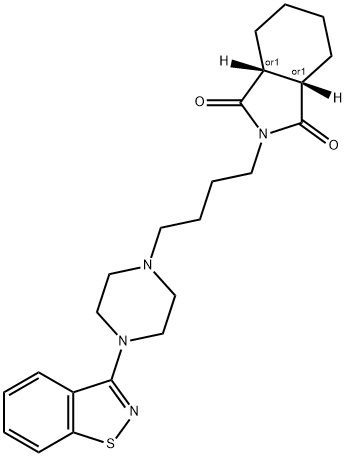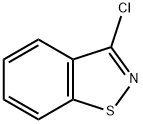
PEROSPIRONE
- Product NamePEROSPIRONE
- CAS150915-41-6
- CBNumberCB3101658
- MFC23H30N4O2S
- MW426.57
- MDL NumberMFCD00866669
- MOL File150915-41-6.mol
- MSDS FileSDS
Chemical Properties
| storage temp. | Store at -20°C |
| solubility | Soluble in DMSO |
| form | Solid |
| color | White to Off-White |
| FDA UNII | N303OK87DT |
PEROSPIRONE Price
| Product number | Packaging | Price | Product description | Buy |
|---|---|---|---|---|
| TRC P288903 | 10mg | $90 | Perospirone |
Buy |
| AK Scientific M813 | 25mg | $95 | Perospirone |
Buy |
| ChemScene CS-0019906 | 10mg | $120 | Perospirone 99.51% |
Buy |
| American Custom Chemicals Corporation API0008732 | 25MG | $225.75 | PEROSPIRONE 95.00% |
Buy |
| ChemScene CS-0019906 | 50mg | $420 | Perospirone 99.51% |
Buy |
PEROSPIRONE Chemical Properties,Usage,Production
Description
Perospirone hydrochloride was launched in Japan as a new treatment of schizophrenia and other psychoses. This structurally-related analog of ziprasidone can be classically prepared by alkylation of 1-(3-benzisothiazolyl)-piperazine with the appropriate N- (chlorobutyl)-succinimide. As a result of an in vitro determination of its binding profile, perospirone demonstrated a high affinity for 5-HT2, 5-HT1A and D2 receptors as well as a significant but lower affinity for DI and al receptors. Interestingly, these differential effects on neurotransmitters with a high in vivo occupancy of 5-HT2A receptors with lower D2 occupancy seems to provide this new agent with a significantly lower propensity for the development of extrapyramidal symptoms (EPS) and tardive schizophrenia, the main sideeffects associated with classical antipsychotic therapy. Furthermore, perospirone exhibited anxiolytic-like effects in animal models. A long-term clinical trial (> 6 months) in a group of patients suffering from schizophrenia demonstrated the efficacy of perospirone over placebo for the treatment of the positive, negative and general symptoms of schizophrenia at doses of 12 mg to 96 mg t.i.d.Originator
Sumitomo Pharm. (Japan)Definition
ChEBI: (3aR,7aS)-2-[4-[4-(1,2-benzothiazol-3-yl)-1-piperazinyl]butyl]-3a,4,5,6,7,7a-hexahydroisoindole-1,3-dione is a N-arylpiperazine.brand name
LullanPreparation Products And Raw materials
PEROSPIRONE Supplier
Global(63)Suppliers
| Supplier | Tel | Country | ProdList | Advantage | |
|---|---|---|---|---|---|
| +1-781-999-5354 +1-00000000000 |
marketing@targetmol.com | United States | 32161 | 58 | |
| 86-571-88216897,88216896 13588875226 |
sales@hzclap.com | CHINA | 6312 | 58 | |
| 571-88938639 +8617705817739 |
info@dycnchem.com | China | 52849 | 58 | |
| support@targetmol.com | United States | 38631 | 58 | ||
| +86-85511178; +86-85511178; |
peter68@ptchemgroup.com | China | 35425 | 58 | |
| +8618058761490 | info@gihichemicals.com | China | 49983 | 58 | |
| +1-+1(833)-552-7181 | sales@aladdinsci.com | United States | 57505 | 58 | |
| 571-89925085 | sales@amadischem.com | China | 131957 | 58 | |
| 13393721940; 13393721940 |
sales@vcommend.com | China | 10005 | 58 | |
| 001-857-928-2050 or 1-888-588-9418 | sales@chemreagents.com | United States | 10186 | 62 |
150915-41-6, PEROSPIRONERelated Search
PROMPT×
PROMPT
The What'sApp is temporarily not supported in mainland China
The What'sApp is temporarily not supported in mainland China
Cancel
Determine

